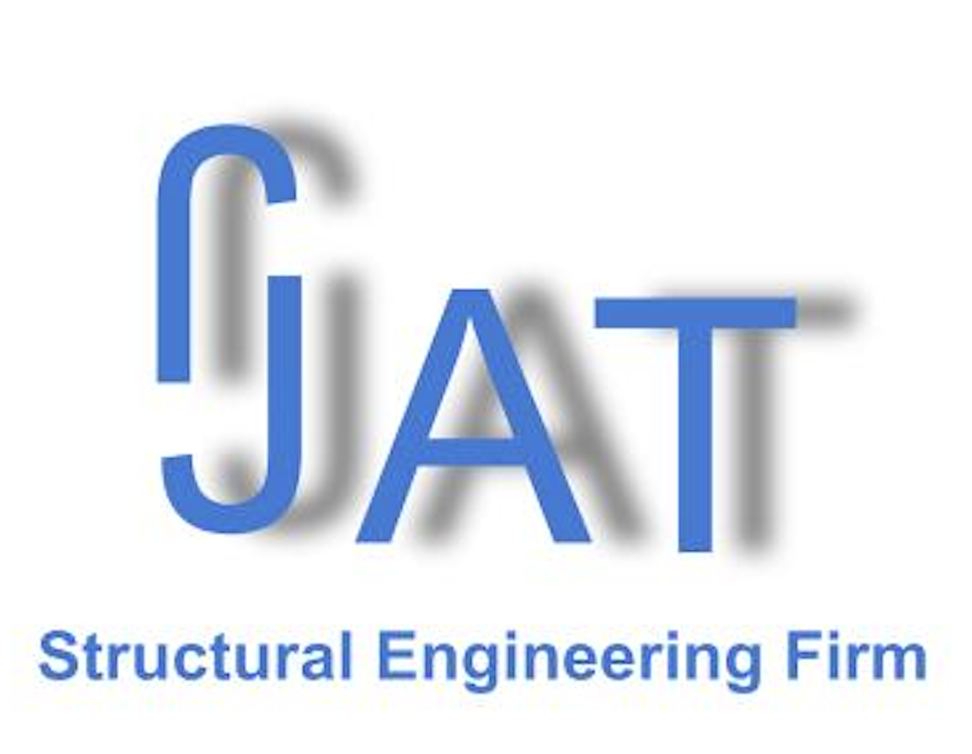

Prochnow Auditorium
Location Maps
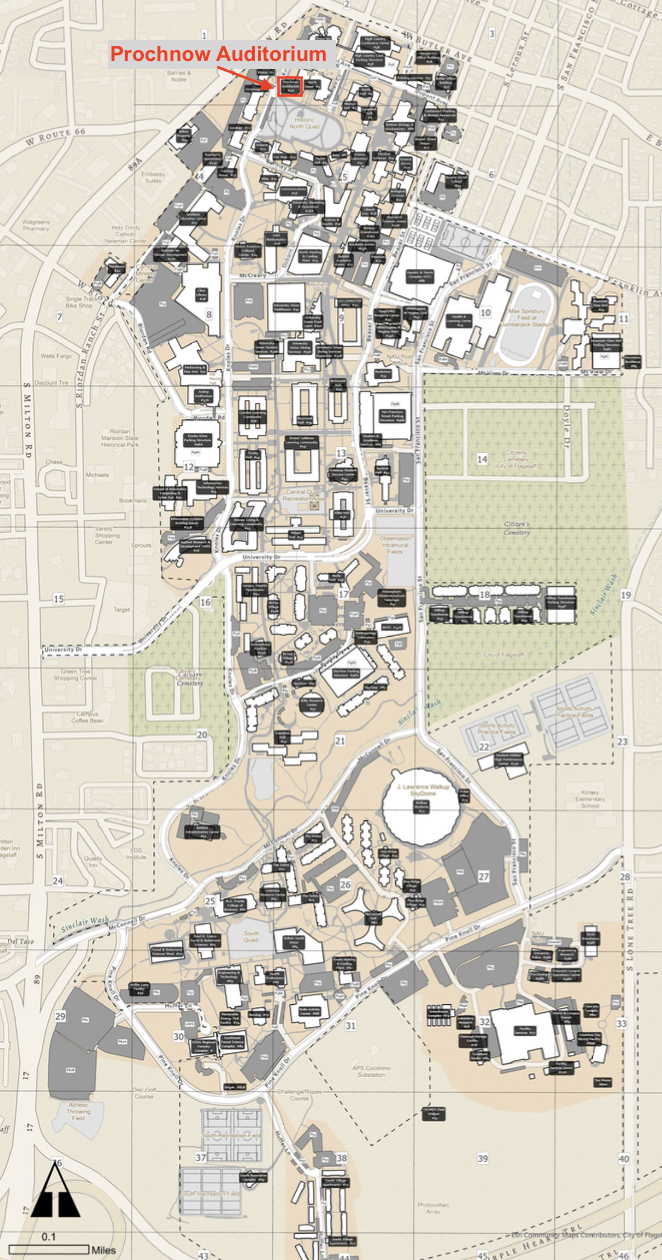
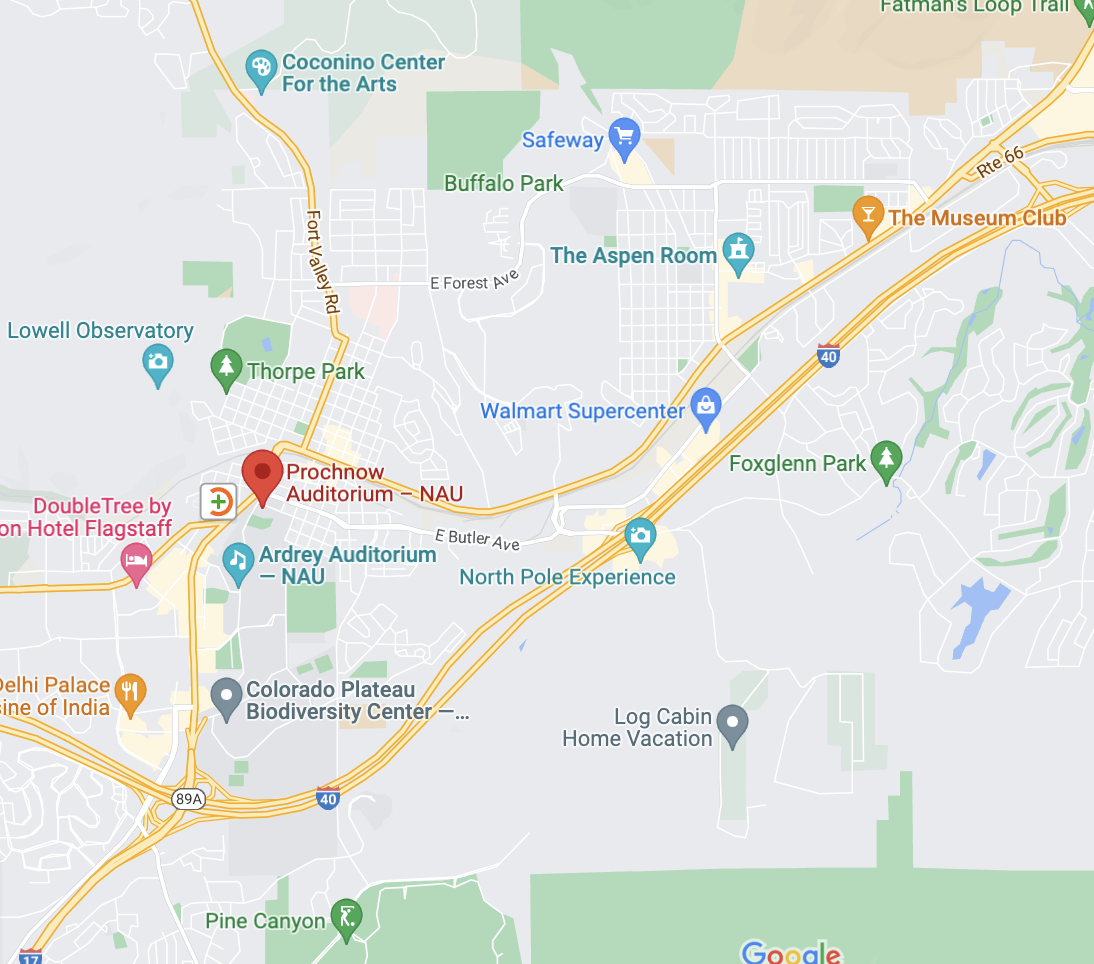
Figure 1: Satalite View of Prochnow Auditorium
The Prochnow Auditorium is located on the Westside of Flagstaff, Arizona. The rigging that will be analyzed is withing the Prochnow Auditorium. Figure 3 demonstrated where the auditoirum is located on the Northern Arizona University Campus. The auditorium is on the Northwest corner of the campus and is a shared building with the restaurant 1899 Grill.

Figure 2: Prochnow Stage
Photo Credits: Jose Espinoza
Figure 3: Campus Map
Tasks are all the main services that will be completed throughout the duration of the praject. Click to see more..
The Gantt Chart is a schedule genereated using Microscoft Projects which will be a resource for the team as this will help the team stay organized and on time.
Staffing Cost of Engineering ServicesThe cost of engineering services states the proposed price of the project based off the scope the client provided. The cost showns a breakdown between supplies, equipment and personnel hours.
The staffing plan consists of all the roles that will be needed in order to meet all the requirements of the project. Each role has it's own decription.
Task 1: Preparation for Site Visit
Task: 1.2 Analyze Existing Plans and Specifications
The team will review the plans Joshua Spear provided and focus on the rigging plans of the Auditorium. Prior to the site visit, the team will be knowledgeable on the girder, beam, trusses, and connection types that are included in the rigging .
Task: 1.3 Code Review
The team will do a code review which will involve researching the code used when the rigging was being designed. The goal of this task is to determine and acquire the code required when the rigging was constructed. The current code requirements to modify existing structures will also be reviewed.
Task: 1.4 Plan for Site Visit
The team will create a plan sheet of the rigging to easily identify all members on the rigging when the team is on-site. A list of action items will also be created to assure the team is documenting all the necessary information.
Group members will discuss how equipment will be operated to ensure safety during the site visit.
Task 2: Site Visit
Task: 2.1 Take Photographs
The teams will take photographs of structurally significant points for the team to reference when the team is not on site. The significant points will include areas where the structure shows deterioration, if any, or existing deformations. Photographs will be numbered and labeled according to drawings to confirm the actual location of elements such as connection to the drawings.
Task: 2.2 Measurement Procedure
Group members will measure lengths of beams, lengths of flanges, widths of beams, height of rigging, and lengths between connections. Assumptions will be made such as if similar beams are used the team will assume lengths of beams will be similar.
Task: 2.3 Identify Existing Loads on Rigging
The team will identify loads on the rigging which may include curtains, lights, speakers, decorations, projector, ect. These loads will be classified in a later task.
Task 3: Structural Analysis
Task: 3.1 Classify and Document Potential Dead & Live Loads
Group members will identify live loads and dead loads on the rigging. A list of both load types will be created and documented.
Task: 3.2 Create a 3D Model & Analyze
This Task will involve creating a 3D model of the rigging structure. This task will be accomplished by analyzing shear, moment and deflections. The demands will be determined by the existing loadings. The capacities will be identified using the steel manual and steel material. The team will ensure the demand is below the capacity.
Task: 3.3 As-Built Drawings and Load Map
Group members will create as-built drawings by using AutoCAD and the acquired field data collected in task 2.0. The loading map will also be created and this will be an elevation view indicating the path of the loads.
Task: 3.4 Assess Results of Analysis
The team will also ensure the results are applicable and logical.
Task: 3.5 Identify Optimal Load Placements
Based on the model and result assessments, the team will narrow down the potential locations of proposed loads to identify potential loading locations. The optimal load placement will be selected based on the client’s preferences and needs.
Task 4: Project Impacts
The team will assess the project impacts of additional loads onto an existing rigging system. The categories of the impacts that will be evaluated are social, economic, and environmental.
Task 5: Project
Deliverables
Task: 5.1 30% Deliverables
Task 1.0 Plan Review will be completed. Task 2.0 Site Visit will begin and Task 2.1 Take Photographs and Task 2.2 Measurements Procedures will be completed. The team will create a report and presentation reflecting all the work that has been completed this far.
Task: 5.2 60% Deliverables
Task 2.3 Identify Existing Loads on Rigging will be completed, concluding Task 2.0 Site Visit. Task 3.0 Structural Analysis and Task 4.0 Project Impacts will be underway by this point. The team will create a report and presentation reflecting all the work that has been completed this far.
Task: 5.3 90% Deliverables
Task 3.0 Structural Analysis and Task 4.0 Project Impacts will be completed. The team will create a report and presentation reflecting the work completed this far and implicated precious comments on presentation.
Task: 5.4 Final Deliverables
This deliverable includes the final report, final presentation, and finished website. All feedback from the previous deliverables should be addressed by the final submission. All tasks from 1.0 to 5.0 will be completed.
Task 6: Project Management
Task: 6.1 Meetings
The team will organize team meetings to ensure deliverable deadlines are being met and other tasks are being properly completed.
Task: 6.2 Schedule
A schedule will be created in order to maintain deadlines throughout the semester. The schedule will be visualized using a Gantt chart.
Task: 6.3 Resource Management
The team will keep track of the number of hours being spent on the project. This will be accomplished by logging hours into time cards in a shared excel file.
Exclusions:
Structural Analysis of Auditorium
The team will not evaluate the structural integrity of the entire auditorium. This includes the roof, columns and beams that do not pertain to the rigging.
Altering the Existing Rigging
The team will not redesign the rigging to withstand loads of future users. The structure will be evaluated, and the team will only provide a report stating all the results.
Installation of Equipment onto the Rigging
The team will not be responsible for installing the future user’s equipment. This equipment may be speakers, light systems, curtains, etc.
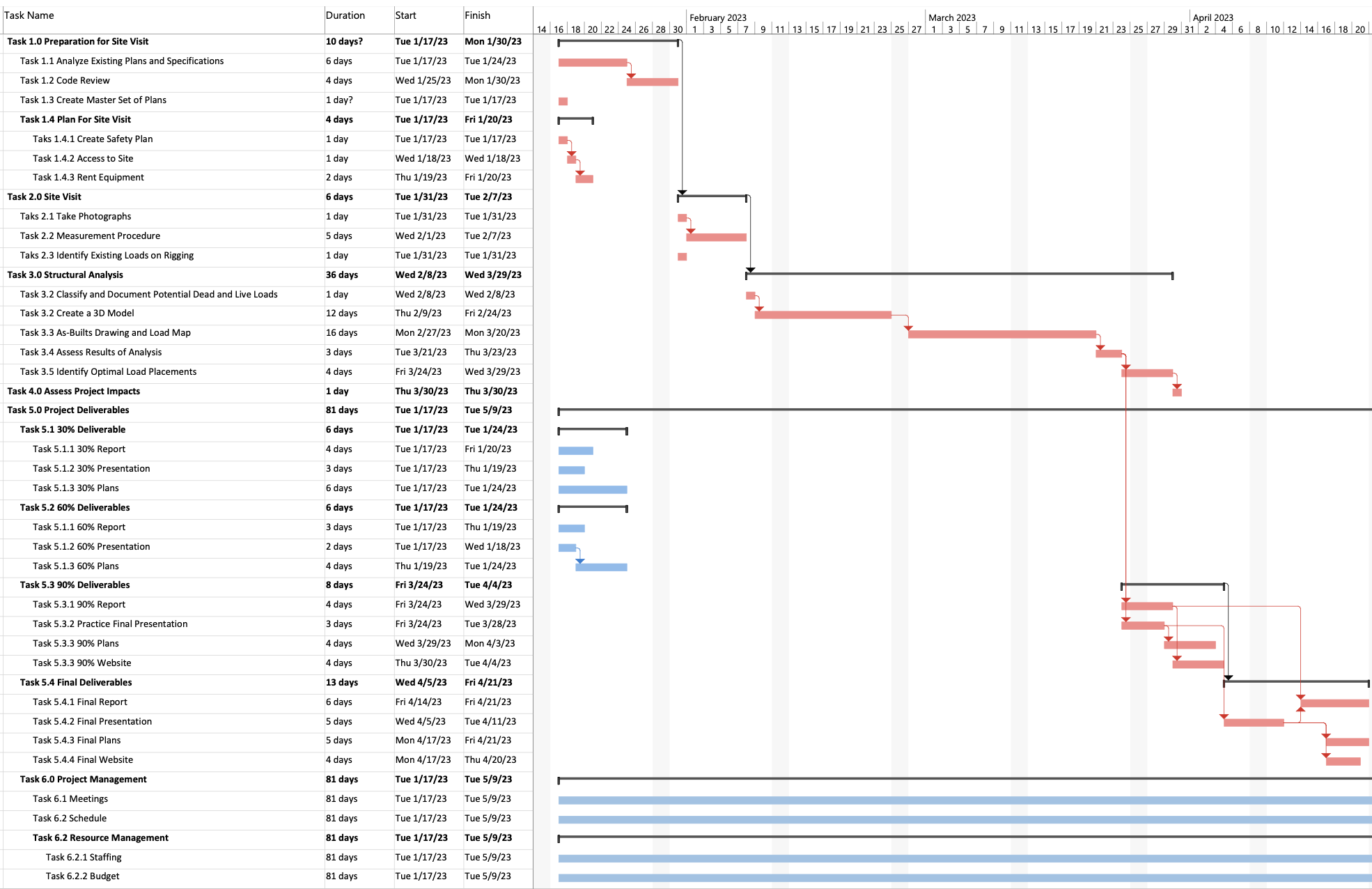
Senior Engineer (SRE)
The senior engineer will be responsible for the management of this project, providing technical oversight, and checking the engineering's work. A senior engineer will be required to have at least five years of engineering work experience as well as a Professional Engineering certification.
Engineer (EGR)
The engineer will be responsible for structural analysis of the rigging on site and compiling the results into technical papers.An engineer will be required to be a certified Professional Engineer.
Drafter (DFT)
The drafter will be responsible for the modeling of the rigging. This will include creating the 3D model from measurements and photographs provided as well as creating 2D as-built drawings and the load map. A drafter will be required to have at least a year of experience working with SAP2000.
Surveyor (SUR)
The surveyor is responsible for gathering equipment, taking measurements, and taking photographs of the rigging. Any rental equipment will be covered in this project’s expenses. They will be required to have 2 years of experience in building surveying.
Intern (INT)
The intern is responsible for assisting, shadowing, and receiving training from the drafter, engineer, and senior engineer.An intern is required to be a 2nd year or above engineering or construction student at an ABET Accredited University or have two years of experience in engineering or construction.
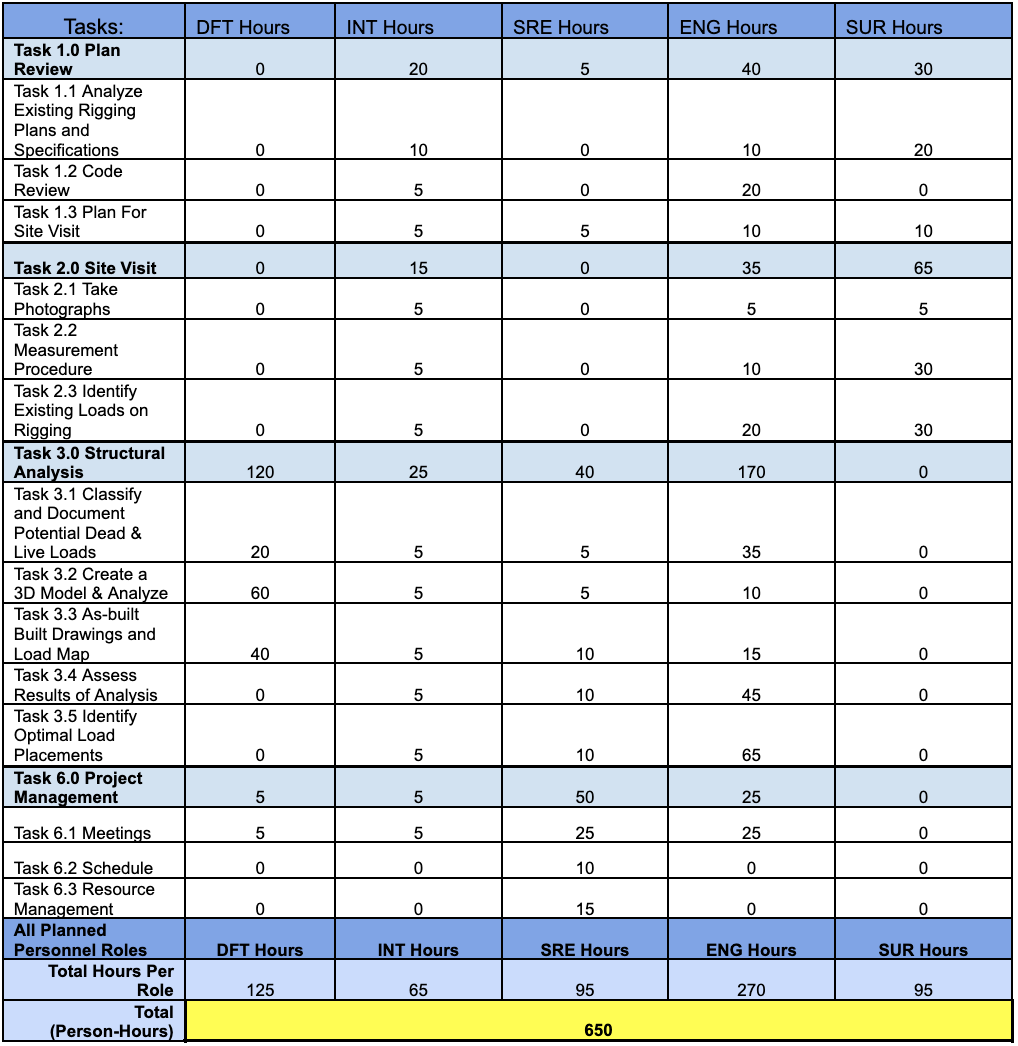
Table 1: Person-Hours Breakdown
The table above is a detailed tables showing how many hours each staff member is contributing to each task.
The total cost of rigging analysis of the Prochnow Auditorium is estimated to be $70,564 upon completion of the project as summarized in Table 2. The total personnel hours allocated to this project makes up the majority of total cost as the majority of the supplies and equipment are only used during the 8-day site visit.

Table 2: Cost of Engineering Services
created with
HTML Designer .